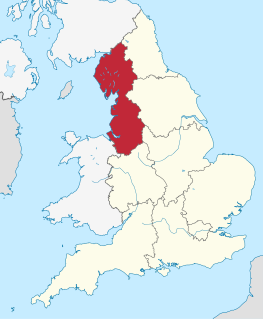
Campanula is one of several genera in the family Campanulaceae with the common name bellflower. It takes both its common and its scientific name from its bell-shaped flowers—campanula is Latin for "little bell".

Campanula latifolia, the giant bellflower, is a species of bellflower in the family Campanulaceae. It is also known as the large campanula and the wide-leaved bellflower. It is native to Europe and western Asia and is widely grown as an ornamental plant.

Cymbalaria muralis, with common names ivy-leaved toadflax, Kenilworth ivy, coliseum ivy, Oxford ivy, mother of thousands, pennywort, wandering sailor, is a flowering plant native to Mediterranean Europe and widely naturalised elsewhere.
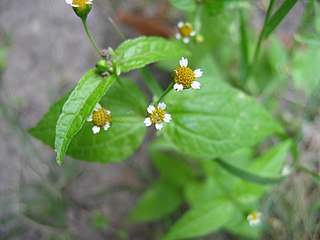
Galinsoga parviflora is an herbaceous plant in the Asteraceae (daisy) family. It has several common names including guasca (Colombia), mielcilla, galinsoga, gallant soldier, quickweed, and potato weed.

Campanula trachelium, the nettle-leaved bellflower, is a species of bellflower. It is a Eurasian blue wildflower native to Denmark and England and now naturalized in southeast Ireland. It is also found southward through much of Europe into Africa.
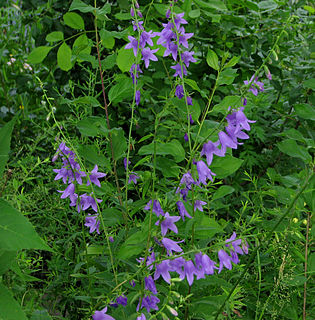
Campanula rapunculoides, known by the common names creeping bellflower, or rampion bellflower, is a perennial herbaceous plant of the genus Campanula, belonging to the family Campanulaceae.
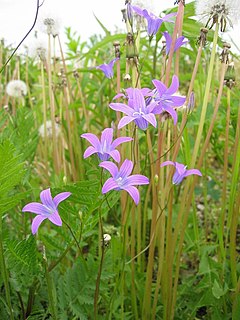
Campanula patula or spreading bellflower is a plant species of the genus Campanula. It can grow to more than half a meter high. This delicate bellflower bears lateral branches of pale blue or white flowers that are upright and funnel shaped. The leaves are narrow and pointed. Branches are often supported by the surrounding vegetation, so the plants can appear prostrate. The main difference between this and other bellflowers is that the petals in the bell are spread out and more pointed and this gives this species its common name.

Veronica serpyllifolia, the thyme-leaved speedwell or thymeleaf speedwell, is a perennial flowering plant in the plantain family. It can be found on most continents.

Potamogeton praelongus, commonly known as whitestem pondweed in North America and Long-stalked Pondweed in Britain, is a large, perennial aquatic plant in the family Potamogetonaceae. It is widely distributed in lakes and rivers in the northern hemisphere, but is sensitive to poor water quality.
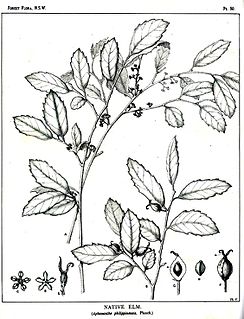
Aphananthe philippinensis is a common rainforest tree in the Cannabaceae family. In Australia it occurs from the Manning River in New South Wales to near Herberton in tropical Queensland. It was first described from the island of Luzon in the Philippines, hence the species name. The generic name of Aphananthe refers to insignificant flowers. This plant also occurs on the Solomon Islands and in Papua New Guinea

Pelargonium peltatum is a scrambling perennial plant with shallow or deeply five lobed, circular to heart-shaped, somewhat fleshy leaves, sometimes with a differently coloured semicircular band, that has been assigned to the cranesbill family. It carries umbel-like inflorescences with 2–10, white to mauve, bilateral symmetrical flowers, each with a "spur" that is merged with the flower stalk. It is known by several common names including ivy-leaved pelargonium and cascading geranium. It is native to southern and eastern South Africa. In its home range, it flowers year round but most vigoriously from August to October.

Goodenia hederacea, the ivy goodenia or forest goodenia,is a flowering plant that is endemic to Australia. It may be prostrate or grow up to 80 cm (31 in) in height with stems arising from the base. Leaves are 10 to 120 mm long and 3 to 25 mm wide with a green upper surface, and a lower surface which may be hairless or tomentose. The yellow flowers are 8 to 15 mm long and appear between August and April in the species native range. The species occurs in alpine woodland, forest and grassland in ranges and coastal areas of Queensland, New South Wales and Victoria.

Potentilla norvegica is a species of cinquefoil known by the common names rough cinquefoil, ternate-leaved cinquefoil, and Norwegian cinquefoil. It is native to Europe, Asia, and parts of North America, and it can be found elsewhere as an introduced species.

Muggleswick, Stanhope and Edmundbyers Commons and Blanchland Moor is a Site of Special Scientific Interest in County Durham and Northumberland, England. It consists of two separate areas, the larger—encompassing the upland areas of Muggleswick, Stanhope and Edmundbyers Commons—in the Derwentside and Wear Valley districts of north Durham, the smaller—Blanchland Moor—in the Tynedale district of south-west Northumberland.

Potamogeton obtusifolius, known as blunt-leaved pondweed, is an aquatic plant in the genus Potamogeton. It grows mainly in mesotrophic to eutrophic lakes, ponds and ditches, rarely in brackish water. It occurs primarily in Central Europe, the British Isles, Fennoscandia and eastern North America.

Iva xanthiifolia, synonym Cyclachaena xanthiifolia, known as giant sumpweed or, in Britain and Ireland, marsh-elder, is a North American plant species in the sunflower family. It is believed to be native to the Great Plains but now found across much of southern Canada and the contiguous United States, though rarely in the Southeast. It has been introduced and semi-naturalized in central and southern Britain, partly via seeds bought for bird food.

Oxalis articulata, known as pink-sorrel, pink wood sorrel, windowbox wood-sorrel, sourgrass,Netho (khatta) saag (India) is a perennial plant species in the genus Oxalis native to temperate South America. It has been introduced in Europe in gardens and is now naturalized in these areas.

Helianthus decapetalus, known by the common names thinleaf sunflower and thin-leaved sunflower, is a perennial forb in the sunflower family. It is native to the Eastern and Central United States and Canada, from New Brunswick west to Iowa, Wisconsin, and Ontario, south as far as Georgia and Louisiana. It produces yellow composite flowers in late summer or early fall.

Astragalus danicus, known as purple milk-vetch, is a species of flowering plant in the family Fabaceae (legumes), which is native to Europe.

Minuartia recurva, the recurved sandwort or sickle-leaved sandwort, is a rare tufted, calcifugous chamaephyte perennial herb of the Caryophyllaceae family.




